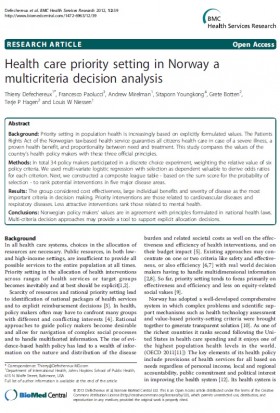This website uses cookies so that we can provide you with the best user experience possible. Cookie information is stored in your browser and performs functions such as recognising you when you return to our website and helping our team to understand which sections of the website you find most interesting and useful.
Health care priority setting in Norway a multicriteria decision analysis. (2012)

รายละเอียดเพิ่มเติม
Health care priority setting in Norway a multicriteria decision analysis.
Thierry DefechereuxEmail author, Francesco Paolucci, Andrew Mirelman, Sitaporn Youngkong, Grete Botten, Terje P Hagen and Louis W Niessen
Abstract
Background
Priority setting in population health is increasingly based on explicitly formulated values. The Patients Rights Act of the Norwegian tax-based health service guaranties all citizens health care in case of a severe illness, a proven health benefit, and proportionality between need and treatment. This study compares the values of the country’s health policy makers with these three official principles.
Methods
In total 34 policy makers participated in a discrete choice experiment, weighting the relative value of six policy criteria. We used multi-variate logistic regression with selection as dependent valuable to derive odds ratios for each criterion. Next, we constructed a composite league table – based on the sum score for the probability of selection – to rank potential interventions in five major disease areas.
Results
The group considered cost effectiveness, large individual benefits and severity of disease as the most important criteria in decision making. Priority interventions are those related to cardiovascular diseases and respiratory diseases. Less attractive interventions rank those related to mental health.
Conclusions
Norwegian policy makers’ values are in agreement with principles formulated in national health laws. Multi-criteria decision approaches may provide a tool to support explicit allocation decisions.
Full Text: http://www.biomedcentral.com/1472-6963/12/39




